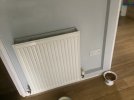Stephen Ireland's pants
Well-Known Member
- Joined
- 21 Dec 2018
- Messages
- 990
Trickle vents on Windows should always be open . Just a tip
Hello mate, your point about rising damp will only go up to 1metre in height is factually wrong . Loads of damp proof surveys will wrongly tell you this, then hope you will pay them to take off to a metre plaster , inject a dpc (waste of time) then re render /plaster with a waterproofer. This will in most cases just keep in any damp that penetrates the wall .Only 3 ways you can get damp in a house.
Penetrating.
Rising .
Or a leak.
Think we can rule the 1st out as its an internal wall.
Rising can only rise to 1m high is it higher than that hard to tell of the pictures.
But in my experience if a damp course fails in a house it will fail all the way around not on certain walls.
So we're probably down to a leak.
Sounds like it's on the chimney area or close to it and work has been carried out on the chimney previously.
Check the stack and flashing would be my first job
Yes correct but as a rule its normally 1m.Hello mate, your point about rising damp will only go up to 1metre in height is factually wrong . Loads of damp proof surveys will wrongly tell you this, then hope you will pay them to take off to a metre plaster , inject a dpc (waste of time) then re render /plaster with a waterproofer. This will in most cases just keep in any damp that penetrates the wall .
I’ve worked on lots of old properties, chimneys, especially redundant ones can be a “damp” pain in the arse !Yes correct but as a rule its normally 1m.
But it this case it doesn't sound like rising damp as it's in an isolated area on a chimney
There is a lot to agree with there. And a lot to disagree with. Mostly the BBA bashing which like it or not is the baseline standard. But fair on the chemical injection being pap.Really good infoDamp Proofing Old Houses | Heritage Conservation
We see and hear about damp problems in old houses all the time. If we had a pound for every time someone rings about a damp problem, we'd all be very rich. Damp in old houses is perhaps one of the most mis-understood scientific disciplines within the building industry. It has become a fertile...www.heritage-survey.org
Hello mate, your point about rising damp will only go up to 1metre in height is factually wrong . Loads of damp proof surveys will wrongly tell you this, then hope you will pay them to take off to a metre plaster , inject a dpc (waste of time) then re render /plaster with a waterproofer. This will in most cases just keep in any damp that penetrates the wall .



I think I've found the problem? Possibly. I'll upload the pictures in a few minutes. Let me know what you think. Thanks.
Do you have any damp at high level in that area of the chimney?



In the living room? No, just on isolated areas along the base of the living room wall.
The only place where the damp has really risen by a metre or so is on the hallway wall and on the right side of the living wall that backs on to the hallway wall. As well as on the left corner of the living wall, which is opposite a cupboard that houses the combi boiler. The cupboard wall internally is damp free.
In the living room? No, just on isolated areas along the base of the living room wall.
The only place where the damp has really risen by a metre or so is on the hallway wall and on the right side of the living wall that backs on to the hallway wall. As well as on the left corner of the living wall, which is opposite a cupboard that houses the combi boiler. The cupboard wall internally is damp free.

Repainted paint to the left of the socket and below the socket.


Yes.Is the combi boiler in the cupboard of the last pic?


Plumbing to combi boiler leaking?


I‘m not losing any pressure in the combi boiler. Wouldn’t that be the case if there was a leak in the pipes? There are pipes that go from the rad up the kitchen wall into the wall/ceiling. Where the pipes go into the wall/ceiling after that I don’t know. Those pipes are nowhere near the left side of the living wall which has damp. They are next to the hallway wall and the right side of the living wall which has damp. I boxed the pipes in a few years ago.
View attachment 111956
View attachment 111957
a drop in pressure might occur but it only measures your central heating pressure and I presume the combi boiler is supplying your hot water as well. Are any of your radiators not full? do you know where the pipe work for your hot water goes
Is that a party chimney? If so have you asked if the neighbour is having issues ?
The chimney will have a double skin of brick. In other words there's another inner layer of brick inside. Both layers are attached if you get what if mean.
There's a possibility of it being the flashing but it could also be a broken tile/slate issue.
Have you thought about having it taken down if it's not shared ? You could pay out a hell of a lot of money trying to get it fixed because unless the problem is accurately diagnosed you could be chasing it forever without remedy.
